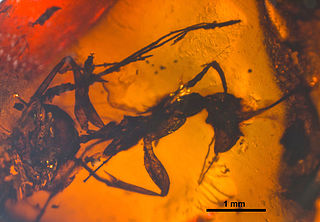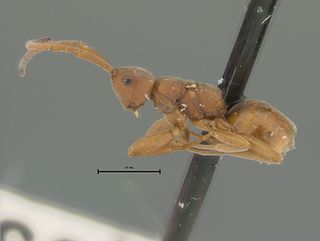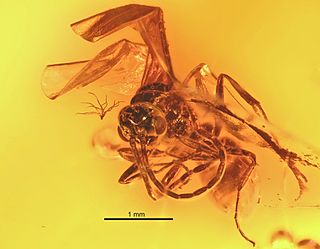
The Cixiidae are a family of fulgoroid insects, one of many families commonly known as planthoppers, distributed worldwide and comprising more than 2,000 species from over 150 genera.

Baltic amber or succinite is amber from the Baltic region, home of its largest known deposits. It was produced sometime during the Eocene epoch, but exactly when is controversial. It has been estimated that this forested region provided the resin for more than 100,000 tons of amber. Today, more than 90% of the world's amber comes from Kaliningrad Oblast of Russia. It is a major source of income for the region; the local Kaliningrad Amber Combine extracted 250 tonnes of it in 2014 and 400 tonnes in 2015.
Electrinocellia is an extinct monotypic genus of snakefly in the family Inocelliidae containing the single species Electrinocellia peculiaris and known from Eocene aged Baltic amber.
Baltocteniza is an extinct monotypic genus of spider in the family Ctenizidae. At present, it contains the single species Baltocteniza kulickae. The genus is solely known from the Early Eocene Baltic amber deposits in the Baltic Sea region of Europe.
Electrocteniza is an extinct monotypic genus of spider in the family Ctenizidae. At present, it contains the single species Electrocteniza sadilenkoi. The genus is solely known from the Early Eocene Baltic amber deposits in the Baltic Sea region of Europe.
Tainosia is an extinct monotypic genus of planthopper in the Nogodinidae subfamily Nogodininae and at present, it contains the single species Tainosia quisqueyae. The genus is solely known from the early Miocene, Burdigalian stage, Dominican amber deposits on the island of Hispaniola.

Ordralfabetix is an extinct genus of planthoppers in the family Lophopidae and containing the single species Ordralfabetix sirophatanis. The species is known only from the Early Eocene, Ypresian stage Oise amber from the Quesnoy locality, Oise Department, France.

Nogodinidae is a family of planthoppers. They have membranous wings with delicate venation and can be confused with members of other Fulgoroid families such as the Issidae and Tropiduchidae. Some authors treat it as a subfamily of the Issidae.

Arostropsis is an extinct genus of broad-nosed weevil in the beetle family Curculionidae known from an Upper Eocene fossil found in Europe. The genus contains a single described species, Arostropsis groehni.
Schwenckfeldina archoica is an extinct species of dark winged fungus gnat in the family Sciaridae known from a solitary Late Oligocene to Early Miocene fossil found in Mexico. S. archoica is the only species in the genus Schwenckfeldina to have been described from fossils found in Mexican amber.
Pristomyrmex rasnitsyni is an extinct species of ant in the genus Pristomyrmex. The species is known from a single Late Eocene fossil which was found in Europe.

Cixiinae is a planthopper subfamily in the family Cixiidae. It is one of three such subfamilies, the other two being the Bothriocerinae and the Borystheninae. While a few species had been tested in a larger study of the Fulgoroidea, neither the Cixiinae nor its tribes were analysed cladistically until 2002. Resolution of tribal relationships is incomplete and additional testing of the tribes with samples larger than one per tribe is needed.

Yantaromyrmex is an extinct genus of ants first described in 2013. Members of this genus are in the subfamily Dolichoderinae of the family Formicidae, known from Middle Eocene to Early Oligocene fossils found in Europe. The genus currently contains five described species, Y. constrictus, Y. geinitzi, Y. intermedius, Y. mayrianum and Y. samlandicus. The first specimens were collected in 1868 and studied by Austrian entomologist Gustav Mayr, who originally placed the fossils in other ant genera until the fossils were reviewed and subsequently placed into their own genus. These ants are small, measuring from 4 to 6 mm in length and can be characterized by their trapezoidal shaped head-capsules and oval compound eyes that are located slightly to the rear of the capsules midpoint, with no known ocelli present.

Zherichinius is an extinct genus of ants in the subfamily Dolichoderinae known from fossils found in amber from the Middle Eocene of Sakhalin island Far eastern Russia and Bitterfeld, Germany. At the time of description the species Zherichinius horribilis and Zherichinius rapax were two of eight ant species known from Sakhalin fossils.
Electropodagrion is an extinct species of damselfly in the family Megapodagrionidae known from a fossil found in Europe. The genus contains a single described species, Electropodagrion szwedoi.

Bradoponera is an extinct genus of ant in the Formicidae subfamily Proceratiinae, and is one of four genera of the subfamily. The genus contains four described species Bradoponera electrina, Bradoponera meieri, Bradoponera similis, and Bradoponera wunderlichi. The species are known from several Middle Eocene amber fossils which were found in Europe.

Embolemidae is a family of small solitary parasitoid wasps with around 70 species in 2 genera distributed around the world. The few species whose biology is known are parasites on planthopper nymphs of the families Achilidae and Cixiidae. There is debate regarding the status of the genus named Ampulicomorpha by Ashmead in 1893, generally considered now to be a junior synonym of Embolemus (e.g.,), though some authorities dispute this (e.g.,)

Pachycondyla succinea is an extinct species of ant in the formicid subfamily Ponerinae described from fossils found in Europe. P. petrosa is one of three middle Eocene Pachycondyla species found in Baltic amber.

Florissantia is an extinct monotypic genus of planthopper in the dictyopharid subfamily Dictyopharinae. The single species, Florissantia elegans, was described by Samuel Hubbard Scudder (1890) from fossils found in the Florissant Formation of Colorado.
The Prussian Formation, previously known as the Amber Formation, is a geologic formation in Prussia, today mostly Kaliningrad Oblast that dates to the Eocene. It holds 90% of the world's amber supply and Baltic amber is found exclusively in the Prussian Formation.










